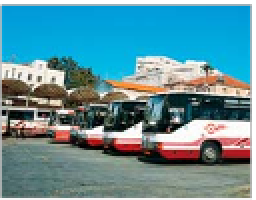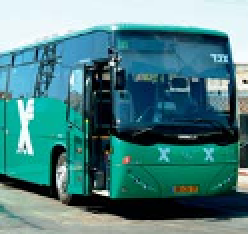Travel Reference
In-Depth Information
Public Transport in the Holy Land
By far the best and most popular way of getting
around Israel and the Holy Land is by bus. Every
town and city has a bus station, and inter-urban
services tend to be frequent and very affordable. In
comparison, rail networks in this part of the world
are extremely limited: Israel has just two lines, and
Jordan one, which is of little use, running, as it does,
north to Damascus. There are no railways at all in
Sinai. Sea transport is limited to just one route, across
the Red Sea between Jordan and Sinai.
services for West Bank
Palestinian towns such as
Bethlehem, Hebron, Jericho
and Ramallah.
Arab shared taxis depart
from a parking lot just outside
the walls opposite Damascus
Gate. They serve all the same
destinations as the buses, but
they are faster and depart far
more frequently.
In general Arab buses do
not go to Israeli towns, and
vice versa. It is possible to
catch an Israeli Egged bus to
Bethlehem, but it drops you
off on the highway outside
town necessitating a 20-minute
walk into the centre.
fares for students, contact the
bus stations or
Egged Tours
,
which has sales offices in all
major towns and cities.
The one drawback to
Israeli buses is that there
are no services on Shabbat
(Sabbath). This means that
you should not plan to travel
any time from late Friday
afternoon to early evening
Saturday. There are no buses
either on Jewish holidays
(see
pp36-9)
. This can prove highly
disruptive for any visitors
caught unawares.
Long-distance Egged buses parked
at Jerusalem central station
LONG-DISTANCE BUSES
Nearly all long-distance
bus routes in Israel are
operated by the Egged com-
pany. This virtual monopoly
at least has the advantage of
making bus travel straightfor-
ward and simple. Except to
the Dead Sea region, services
are frequent. For example
buses d
e
part from Jerusalem
to Tel Aviv every 15 minutes,
A
to Haifa every 45 minutes,
and to Tiberias every hour.
There is rarely any need to
book in advance; you can
simply turn up at the city bus
station and get a ticket for the
next service out. The only
time that you might need to
book in advance is if you are
travelling to Ein Gedi, Masada
or Eilat, as there are only
about four buses a day that
head in this direction.
Given the small size of the
country, journeys are never
very long (the longest one is
from Jerusalem to Eilat, which
lasts around five hours).
Egged buses are comfortable
and air-conditioned, with
plenty of space in the
baggage holds.
There are passes for an
unlimited number of journeys,
which are valid for one or
more weeks. These are called
Israbus cards. For information
on these passes and reduced
TRANSPORT IN
THE PALESTINIAN
TERRITORIES
A modern, long-distance Egged bus
TRAVELLING BY TRAIN
With the constant new
developments in the
administrative situation, public
transport in the Palestinian
territories is forever changing.
In general, there are two
options: Arab buses or shared
taxis
(see p310)
. Arab buses
depart from two stations in
East Jerusalem, one on
Nablus Road (mainly for city
services), the other on
Suleyman Street, opposite the
Old City walls. From one of
these two, visitors can catch
Israel's very limited railway
system comprises just
two
lines: one from Tel Aviv to
A
Jerus
a
lem and a second from
Tel Aviv to Nahariya. The latter
A
runs up the northern Mediter-
ranean coast to near the border
with Lebanon. Although the
line serves several important
destinations, including Haifa
and Acre, the drawback is
that there are few services each
day and on Jewish holidays
trains are very crowded.
The line up the north coast of Israel, slow but scenic

















